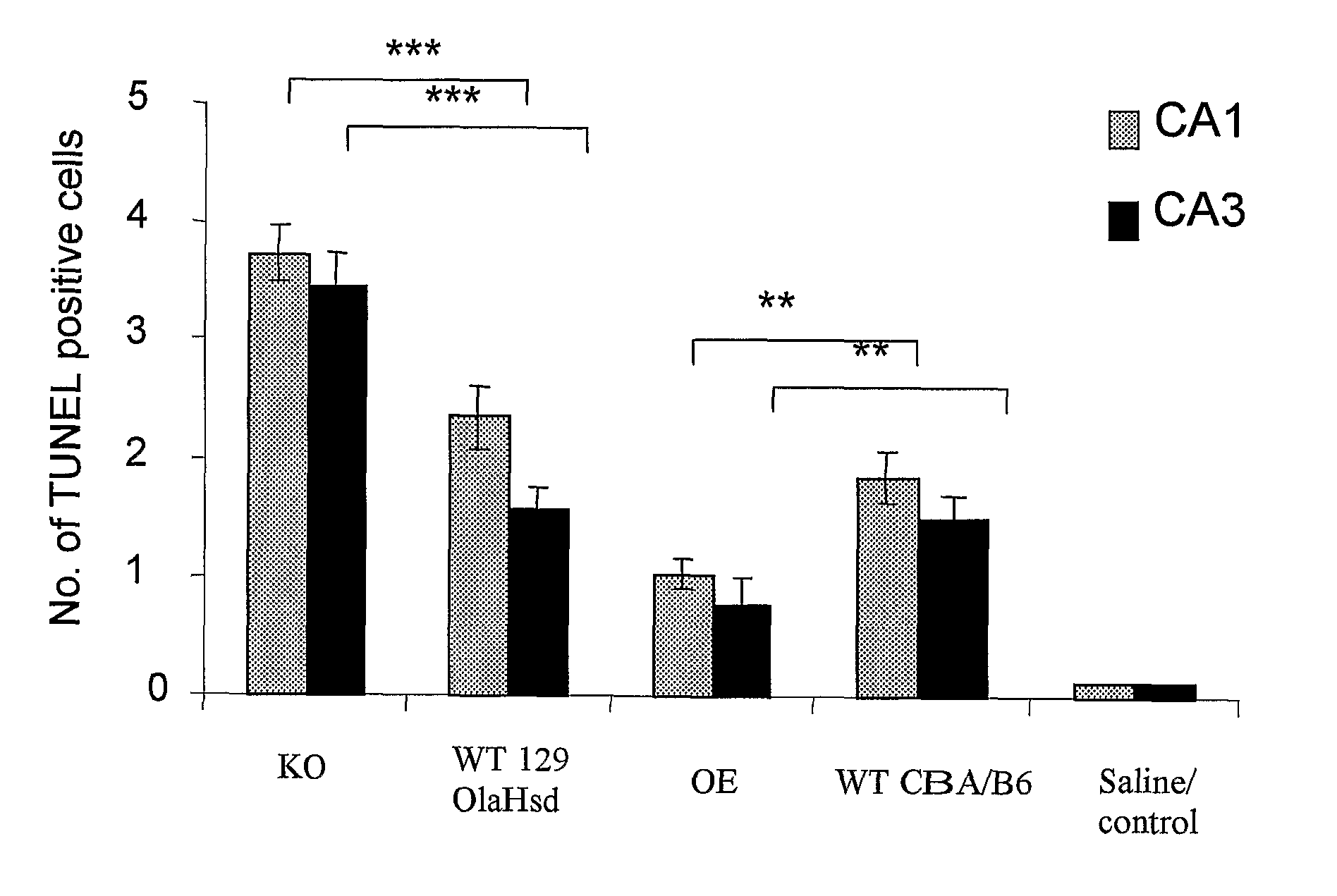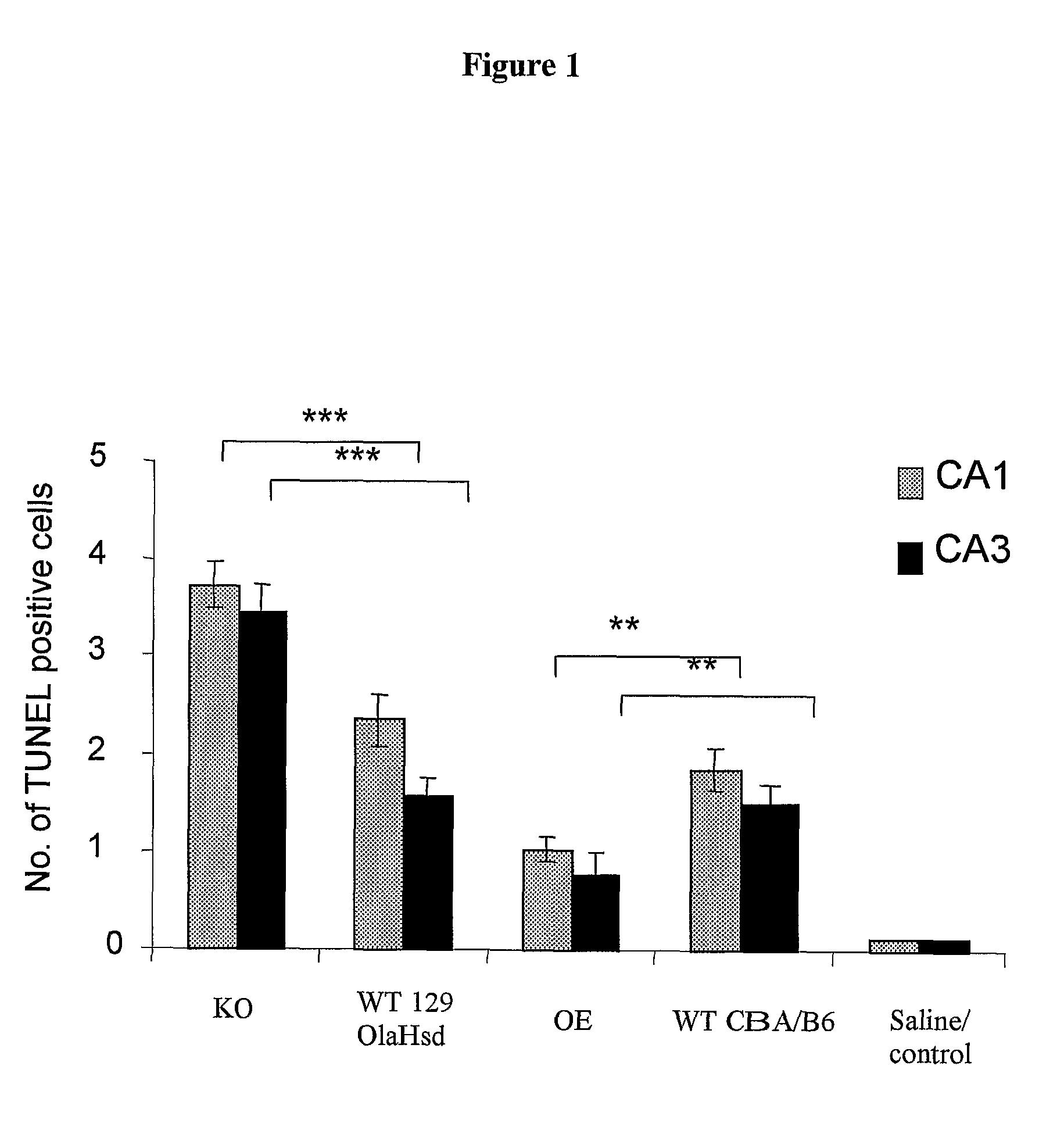Galanin Receptors and Brain Injury
a technology of galanin receptors and brain injury, applied in the direction of hormone receptors, animal/human proteins, biocide, etc., can solve problems such as chemical damage, achieve the effects of reducing cell death, preventing brain damage, or improving the condition of individuals, and reducing cell death
- Summary
- Abstract
- Description
- Claims
- Application Information
AI Technical Summary
Benefits of technology
Problems solved by technology
Method used
Image
Examples
experiment 1
[0108]Intraperitoneal administration of 20 mg / kg kainic acid was used to induce excitotoxic hippocampal damage as previously described (Beer, 1998; Mazarati, 2000; Tooyama et al. (2002) Epilepsia 43 Suppl 9 39-43). Three days later brains were harvested and hippocampal cell death assessed by counting the number of TUNEL-positive cells. The results are displayed in FIG. 1. The number of apoptotic neurons was significantly greater in both the CA1 and CA3 regions of the galanin knockout animals (KO) compared to the strain-matched wild-type controls (WT) (FIG. 1), an increase of 62.9% and 44.8% respectively (**P<0.01, ***p<0.001). Conversely, the degree of cell death was significantly lower in both the CA1 and CA3 regions of the galanin over-expressing animals (OE) than in strain matched controls (WT) (FIG. 1), a decrease of 55.6% and 50.4% respectively (p<0.05).
experiment 2
[0109]To further dissect the neuroprotective role played by galanin in a more tractable in vitro system, both primary dispersed and organotypic hippocampal cultures (Elliott-Hunt, 2002) were used. These two techniques are complimentary since the dispersed hippocampal cultures ensure that observed effects are neuron-specific, whilst the organotypic cultures preserve the synaptic and anatomical organisation of the neuronal circuitry (Elliott-Hunt, 2002) as well as retaining many of the functional characteristics found in vivo (Adamschik et al. (2000) Brain Res. Prot. 5 153-158). The effects of staurosporine and glutamate on neuronal cell death in hippocampal cultures (Prehn, 1997; Ohmori, 1996) were studied. Cell death was visualised by propidium iodide staining. Results are expressed as a percentage of the area expressing fluorescence as compared with the untreated “control” cultures. Staurosporine at 1 μM and 100 nM caused significant and consistent levels of neurotoxicity in both t...
experiment 3
[0111]Having demonstrated that an absence of galanin increases the susceptibility to hippocampal cell death, the studies were extended to the galanin over-expressing mice. A significant reduction in cell death was observed in the galanin over-expressing animals (OE) after exposure to 50 nM or 100 nM staurosporine, compared to strain-matched wild-type controls (WT) (FIG. 2C; n=4, **p<0.01, ***p<0.001).
PUM
| Property | Measurement | Unit |
|---|---|---|
| Length | aaaaa | aaaaa |
| Affinity | aaaaa | aaaaa |
Abstract
Description
Claims
Application Information
 Login to View More
Login to View More - R&D
- Intellectual Property
- Life Sciences
- Materials
- Tech Scout
- Unparalleled Data Quality
- Higher Quality Content
- 60% Fewer Hallucinations
Browse by: Latest US Patents, China's latest patents, Technical Efficacy Thesaurus, Application Domain, Technology Topic, Popular Technical Reports.
© 2025 PatSnap. All rights reserved.Legal|Privacy policy|Modern Slavery Act Transparency Statement|Sitemap|About US| Contact US: help@patsnap.com



